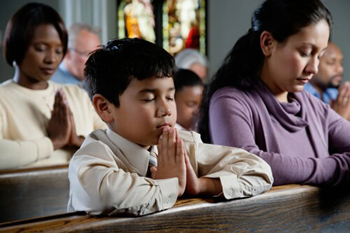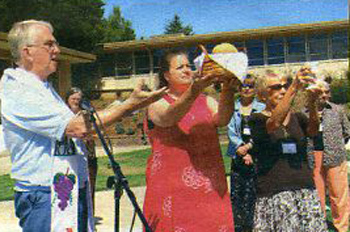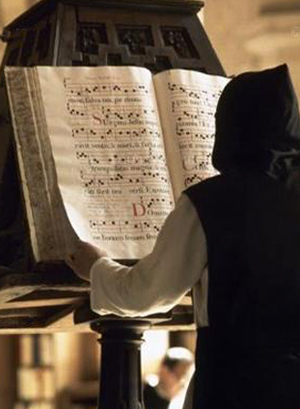Dialogue Mass - I
A Plea for Silent Participation in the Liturgy
Dr. Carol Byrne, Great Britain
Some priests in the Traditionalist Movement are starting to introduce “dialogue Masses” for their parishioners. To shed light on the inappropriateness of this bad custom of “active participation of the faithful,” nothing could be more useful than this series by Dr. Carol Byrne that TIA starts to post today. We hope our readers will take advantage of the sound arguments of this careful study. The Editor.
Introduction
By common consent, the post-Vatican II Hierarchy of the Church maintains that “active participation” of all the faithful in the liturgy is “the aim to be considered before all else” (1) – even, as it turned out, before respect for Tradition, reverence for the Blessed Sacrament, a sense of the transcendent, or decorum and modesty in the house of God.
Just how did the Bishops arrive at this astonishing conclusion? By falsely presenting the reforms they have implemented as a continuation of the work of Pope Pius X whose motu proprio, Tra le Sollecitudini (TLS) first contained the word “active” in its Italian (though not, significantly, in its Latin) version to describe lay participation in the Mass.
 Praying silently at Mass, a centuries long tradition
Praying silently at Mass, a centuries long tradition[color][size][font]
It is pertinent to ask how such a word, dangerously imprecise in its scope, could have found its way into a juridical code of sacred music intended to apply the Pope’s instructions on the liturgy with the force of law and by his own Apostolic Authority.
“Activity” had never been a defining characteristic of lay participation at Mass throughout the Church’s history. Therefore, some explanation is needed as to why it suddenly acquired an overwhelming significance in the early part of the 20th century and how it came to have a far reaching effect in the Liturgical Movement.
History has shown that the single word “active” created a Mexican wave that rippled through the 20th century, gathering momentum as it went, until it engulfed the entire Church with the blessing of Vatican II’s Constitution
Sacrosanctum Concilium on the Liturgy (1963). Ever since, “active participation” has taken on a life of its own and continues to be reinforced with a zeal surpassed only by the hostility of the reformers for the traditional Latin Mass.
We know from one of the progressivist Fathers of Vatican II, Card. Godfried Danneels of Belgium who had been involved in drafting the Constitution on the Liturgy, that the aim of “active participation” was to democratize the liturgy by blurring the distinction between priestly and lay roles:
“From its very beginnings, the aim of the liturgical movement, which originated in Belgium in 1909, was to close the gap between the official liturgy of the priest and that of the people. The term ‘active participation’ was born out of this movement and has since become part of our common usage.” (2)
[/font][/size][/color]
 Active participation makes lay people equal to priests
Active participation makes lay people equal to priests[color][size][font]
Its usage has become so common that hardly anyone now stands aghast at the suggestion that lay people can be “empowered” to exercise an official role in the liturgy through their “active participation.” This was a concept promoted by Vatican II, but the traditional teaching of the Church, as explained by Pope Pius XII in
Mediator Dei, is different. (3)
From this we learn that the priest, through the Sacrament of Ordination, acts in the name of the Church, in an official act of the liturgy. Lay people, however, by virtue of their Baptism, merely associate themselves with the official liturgy through internal participation (by faith and prayer).
The result of the new emphasis on “active participation” was that the people in the pews, who had generally participated in the ceremonies of the Roman rite in silence, were now transformed into rivals in a liturgical war with the clergy over the right to officiate in the public prayer of the Church.
St. Pius X’s intentions The subject matter of
Tra le Sollecitudini was the restoration of sacred music, particularly Gregorian chant, in the Church’s liturgy. Its purpose was to lay down the true principles of liturgical music, both vocal and instrumental, to be disseminated throughout the world.
It is of the greatest importance to our study that this
motu proprio was not about congregational singing in the liturgy but about the clergy and the choir as the only legitimate executors of liturgical chant.
It laid down no obligation for the congregation to join in the chant or requirement for lay people (apart from selected choir members)
to be trained in liturgical singing. Nor did it state or even imply that silence on the part of the congregation indicated an absence or deficiency in their full participation in the liturgy.
Some points of concern The
motu proprio was first published in Italian on November 22, 1903, in the
Acta Sanctae Sedis, the official organ of the Holy See, but the Latin version bearing the same date did not see the light of day until much later, after many intervening docuмents. Both texts can be accessed
.pdf]here. (4)
[/font][/size][/color]
 Pope Pius X's aim was to reform Gregorian chant, not active participation
Pope Pius X's aim was to reform Gregorian chant, not active participation[color][size][font]
This wide separation of the texts is a departure from the protocol observed by the compilers of the
Acta Sanctae Sedis, who normally published vernacular and Latin texts consecutively for the purposes of transparency and convenient reference. Furthermore, it was uncharacteristic of the Holy See’s policy to issue a legislative docuмent of such weight and solemnity concerning the entire Catholic world in the vernacular and only much later in the universal language of the Church.
Another notable anomaly is the manner in which the Latin version is dated. Instead of the customary format found in the
Acta Sanctae Sedis since 1865, it was written according to the method of calculation of the ancient Romans as
X Kalendas Decembris. Thus the impression is given that the Latin text had been composed long after TLS, as if it were an afterthought and of relative unimportance. Only those who are familiar with the ancient dating system would realize that
X Kalendas Decembris is, in fact, the equivalent of November 22, the same date as TLS. (5)
This has prompted some to assume that the Italian version, simply because it appeared first, is
the official papal text. (6) TLS may be “official” in the sense of having been published by officials of the Vatican bureaucracy, but the fact remains that the Latin is invariably the only authoritative
and official version of papal docuмents, even if it happens that this text only becomes available later.
Out of sight, out of mind Therefore, it is to be deplored that the Latin version was buried from immediate view and relegated to an inconvenient position. To add to the difficulties in locating the Latin text, the page number in the
Acta Sanctae Sedis was printed as 587 instead of 387, thus misdirecting the researcher.
Why such obfuscation surrounding the only version of the
motu proprio (i.e. the Latin) that conveys in indisputable terms the mind of the Pope? The answer will become clear when we come to examine the important discrepancies between the two docuмents.
Which version to follow – the Italian or Latin? As the use of Latin in drafting docuмents was considered by the Church as the ultimate safeguard of objectivity, it is vitally important for the faithful transmission of the truth in a seamless way. Later generations of Catholics can recognize in the Latin words the exact meaning intended by the Popes. Thus it averted the risk of misleading the faithful through imprecise formulae or the rapid changes in meaning typical of vernacular languages.
As we shall see, misrepresentation is exactly what happened when TLS was placed into the hands of liturgical reformers. An examination of this docuмent will show that it contains a number of key words and phrases for which there is no translational equivalence in the Latin version.
In other words, ideas had been inserted into TLS that pander to the aims and objectives of those who wanted to change the liturgy in ways not envisaged by Pope Pius X.
Someone even managed to get the word attiva (“active”) written into the text of TLS to describe the participation of the laity, a term entirely missing in the Latin version.
It is noteworthy that the reformers could not have misinterpreted the Pope’s words in the Latin version because it was drafted with tamper-proof precision designed to give the crystal clear meaning of the Pope and deny any wiggle room for liturgical interventionists. But, for all its official status, the Italian version, as with all docuмents in the vernacular, could offer no such guarantees. In fact, the more it was translated into other vernacular languages, the greater the confusion and error that was transmitted.
Continued [/font][/size][/color]